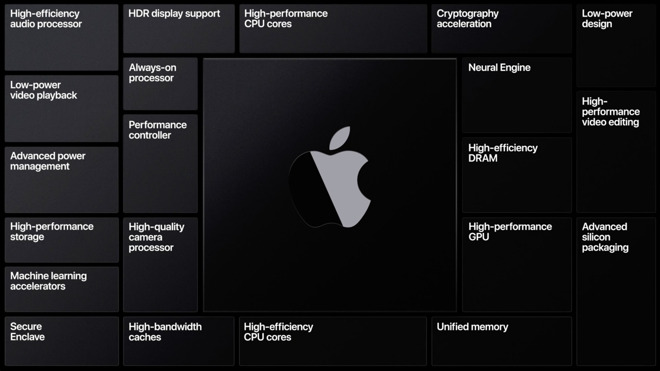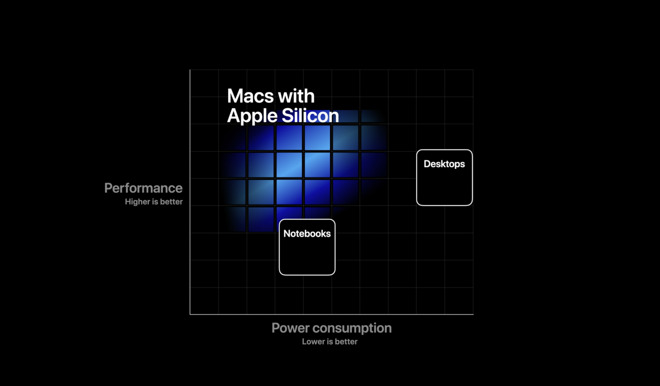Some observers were surprised that Apple's big news in transitioning Macs away from Intel processors didn't refer to the move as a migration to "ARM." Instead, Apple's chief executive Tim Cook introduced it as a move to Apple Silicon. Here's why.

Apple's advantages in chip-making, and what's coming in Apple Silicon
Apple Silicon is a head and shoulders above ARM
The A12Z chip that Apple is currently using in its latest LiDAR iPad Pro and its first generation Apple Silicon chip in the Mac mini developer transition kit does incorporate ARM CPU cores. But that ARM Architecture CPU is not the most significant reason Apple is moving away from Intel's chips on Macs.
Apple alluded to this in referring to its own custom silicon as being an "SoC," or System on a Chip. Over the past decade, Apple has developed a series of SoCs that incorporate essentially an entire logic board of chips that a typical PC would require into a single chip that can be mass produced and used across multiple devices from its iPhone, to iPad, to Apple TV and even HomePod.
The primary advantage of this integration was power consumption. ARM supplied licensed CPU reference design cores that provided leading compute performance per watt, leading Apple to make ARM the center core of its SoC designs. ARM cores are also the basis for Apple's M-series components that monitor data from the accelerometer, gyroscope, and barometer to efficiently track how a device is moving over time.

Apple Silicon power consumption to chip performance
The baseband modems supplied by Qualcomm for handling connectivity to mobile networks also incorporates an ARM processor core, but most of the value of these chips comes from the total package of components and proprietary software, not merely the standards-based CPU core serving at its center.
In some respects, Apple's use of ARM cores in its SoCs is similar to its use of Unix in the OS itself. Both are effectively specifications that standardize the operations of low level technology layers. In the same way that Macs are more than just Unix systems, Apple's SoCs are more than just ARM processors.
As with Qualcomm's modems, the customizations, optimizations, and additional layers of proprietary work that Apple adds to its A-series SoCs results in a package that's significantly more valuable than its base components.
That reality is reflected in Apple's custom silicon being a lot more than just an "ARM chip," and helps to explain why Apple's SoCs have increasingly outperformed other ARM-based SoCs developed by Qualcomm, Nvidia, Samsung, and others.
Apple Silicon brings more than ARM to the Mac
Apple highlighted a series of features of its custom silicon SoCs that will enhance future Macs. Simply moving to an ARM CPU core itself wasn't even one of them. Most of the advantages Apple emphasized in the move to its own silicon referred to unique, custom-developed features of its SoCs.
These include high-efficiency audio processing, low power video playback, advanced power management, a high-performance storage controller, machine learning accelerators, the Secure Enclave, a performance controller, a high-quality camera processor, cryptography acceleration, the Neural Engine, the Apple GPU, and a unified memory architecture.
Apple specifically stressed the benefits from using its own Apple Silicon with examples such as accelerating Final Cut Pro tasks using the Neural Engine. We recently profiled Alogoriddim's new djay Pro AI, which similarly leans on the Neural Engine to enable entirely new kinds of sophisticated audio processing. Going forward, developers will make increasingly sophisticated use of Apple's custom inference engine to handle machine learning and artificial intelligence tasks that are not simply ARM features.
Additionally, one of the most complained about issues on modern Macs is their substandard webcams delivering poor quality images. Modern iOS devices leverage Apple's sophisticated Image Signal Processor to perform incredible feats in computational photography that are largely driven by that custom ISP silicon. With the same SoC, Apple can bring these imaging improvements to the Mac.
The unique TBDR design of the Apple GPU also brings to the Mac, for the first time, the low memory graphics architecture that has been optimized to enable iOS games to deliver impressive performance. This is the same GPU approach that powered the Sega Dreamcast, and was used by Sony to power its handheld PS Vita.
Some have doubted whether a "mobile GPU" could perform competitively with existing Mac GPUs, but Apple's wide graphics architecture has been driving high-resolution Retina display iPads for nearly a decade already. Optimized for Metal, a variety of Apple Arcade titles already perform impressively on iOS devices while causing a high-end Intel Mac to kick on its fans while struggling to keep up. That may come in part from titles being optimized for iOS, but it suggests that new Apple Silicon Macs will not be struggling to keep up with the graphics on Intel Macs.
Along the same lines, iOS devices powered by Apple's recent SoCs can blaze through encryption and decoding tasks that can be embarrassingly slow on Intel Macs. Apple specifically noted that its Macs with its modern silicon would enable higher quality Sidecar connectivity with iPads than is currently possible.
These examples are not general features licensed to Apple by ARM -- they are custom silicon work developed at Apple. Other SoC vendors such as Qualcomm have developed their own implementations of some of these features, but they are not simply components of generic ARM licensed designs.
Intel's own x86 Core processors also incorporate their own proprietary versions of some of these features, including the company's own integrated GPU and media handling logic. Apple's desire to move from Intel's Core package to an SoC design of its own indicates that Apple thinks its own silicon is better.
Additionally, many custom software optimizations already developed for iOS -- such as Metal graphics -- can be brought over to the Mac directly now that both share the same access to Apple's own sophisticated silicon. Currently, Apple has had to develop two versions of Metal, one for iOS and another for the GPUs used on Macs.
So Apple isn't just arbitrarily moving from "x86 to ARM," but rather using its custom silicon work to enhance the performance, features, and deep integration on its Macs. Moving "to ARM" is sort of a side effect of Apple's wanting to use its own custom silicon. Up to this point, Apple has been limited to adding a helper chip like the T2 to its Intel Macs to handle custom features like Touch ID and Touch Bar.
Xcode is ready to go on Apple Silicon, and it probably has been for some time
It's therefore simply inaccurate and misleading to say that Apple is "moving to ARM," because the real transition Apple is making by moving the Mac to its own SoCs involves leveraging the work it has already done to make its own Apple Silicon an industry leader.
Apple's motivation is not like Microsoft's move to ARM
Additionally, the macOS is not moving to ARM in a general sense, as it's not going to run on a Raspberry Pi or a Qualcomm 8cx "always on" PC designed to run "Windows 10 on ARM."
Microsoft has made multiple attempts to deliver Windows on ARM, first with Windows RT and again more recently with Windows 10 on ARM. Apple has no reason to associate its own work with these efforts, in part because its motivations are entirely different.
Microsoft appears to have added ARM support to Windows primarily to benefit from the low power nature of ARM mobile chips, as well as the mobile data modems integrated into Qualcomm's Snapdragon processors. Note that Microsoft isn't moving away from Intel; it's adding support for ARM hardware.
So unlike Apple's consolidation on its own Apple Silicon, which gives it the ability to reuse more of its existing code and natively run iOS apps on new Macs, Microsoft is pursuing a very different goal that increases its development efforts rather than unifying them.
Leveraging better partners for economies of scale
Apple's move to Intel Macs in 2006 was an effort to leverage the economies of scale in the PC industry that were favoring Windows and Intel, rather than the much smaller ecosystem developing new PowerPC chips. Virtually all of the economic activity related to PCs was driving innovation and investment in Intel's chips. But PC sales have since plateaued and there isn't foreseeable growth driving rapid investment and progression of x86 processors. One reason for that is the move toward mobile in smartphones and tablets, with much of the value shift being driven by Apple.
In parallel, Apple's development of a massive mobile platform of iOS and iPad users has driven economies of scale favoring Apple's own custom SoCs. Apple's revenues from mobile not only helped finance sophisticated advances in custom silicon but also the rapid progression of Apple's operating systems, development tools, its first-party apps, and its third-party App Store ecosystem.
Additionally, there's another important development that favors Apple Silicon over Intel's -- advanced chip fabrication at TSMC. While Intel has struggled to significantly improve its processor designs and chip fab process, Apple's chip fab partner TSMC has delivered consistent progress in delivering major, sophisticated advancements in chip production.
The result is that Apple's SoC designs benefit from production efficiencies that make them smaller, faster, more efficient, and cheaper to produce. This too has enhanced Apple Silicon in ways that are not really related to ARM itself.
TSMC's chip production is so sophisticated -- in part due to its own work and partially attributed to American partners who assist it in developing advanced silicon -- that the U.S. has leveraged its dependence on American chip design tool vendors to block TSMC from fabricating chips for Huawei, under the logic that it gains too much support from the Chinese government with too little transparency on how independent Huawei actually is from the PRC.
Regardless of the merits of this policy, this has resulted in TSMC having a sudden need to expand its client base to replace the loss of Huawei's business. This is a fortunate turn of events for Apple, as it enables it more flexibility in handling larger or more diverse orders for custom silicon.
Tim Cook, at WWDC 2020, with an Apple Silicon wafer
At the same time, ARM itself is running into similar issues because it is now majority-owned by Chinese interests [Clarification: ARM Ltd is mostly owned by Softbank; only its ARM China venture, servicing the Chinese market, is majority-owned by Chinese interests.]. For this reason, Apple has further needs to be looking into alternatives to ARM's intellectual property. Apple may likely pursue the same kind of distancing independence from ARM reference designs as it demonstrated with Imagination Technologies [note that Imagination is now majority-owned by Chinese investors]. Apple ended up developing a custom GPU with reduced licensing dependence on Imagination. If it does the same thing with regard to ARM, we could eventually see a custom "Apple CPU" emerge in future Apple Silicon.
All of which contributes to the reasons Apple is framing its migration away from Intel as a move to its own technology, rather than being a Microsoft-like move to partner with ARM to hedge its bets.